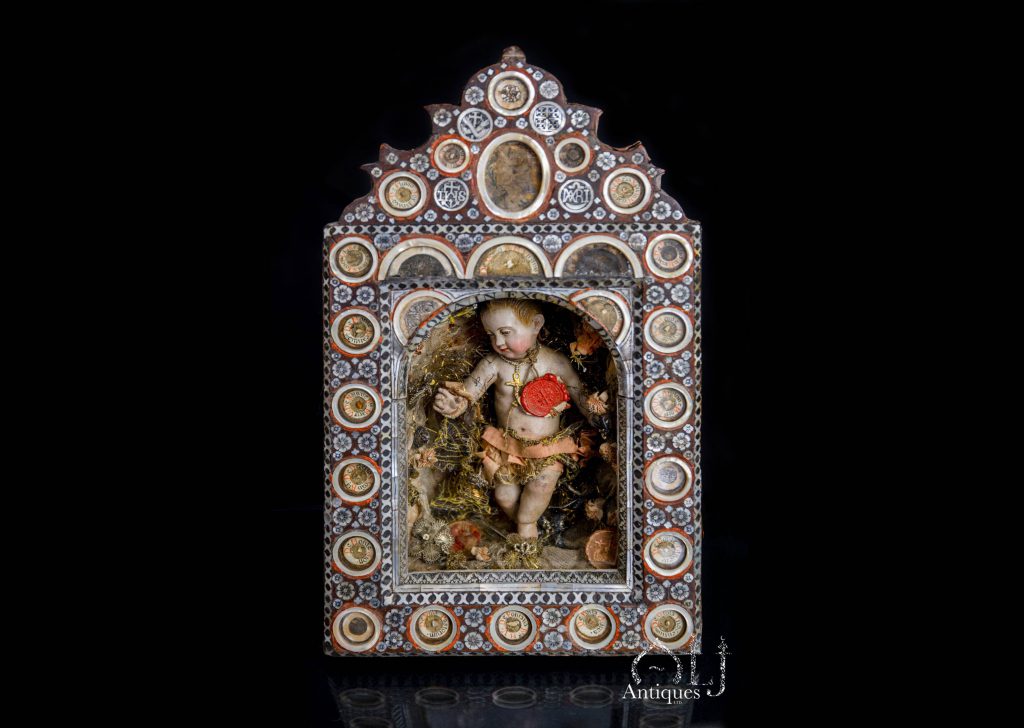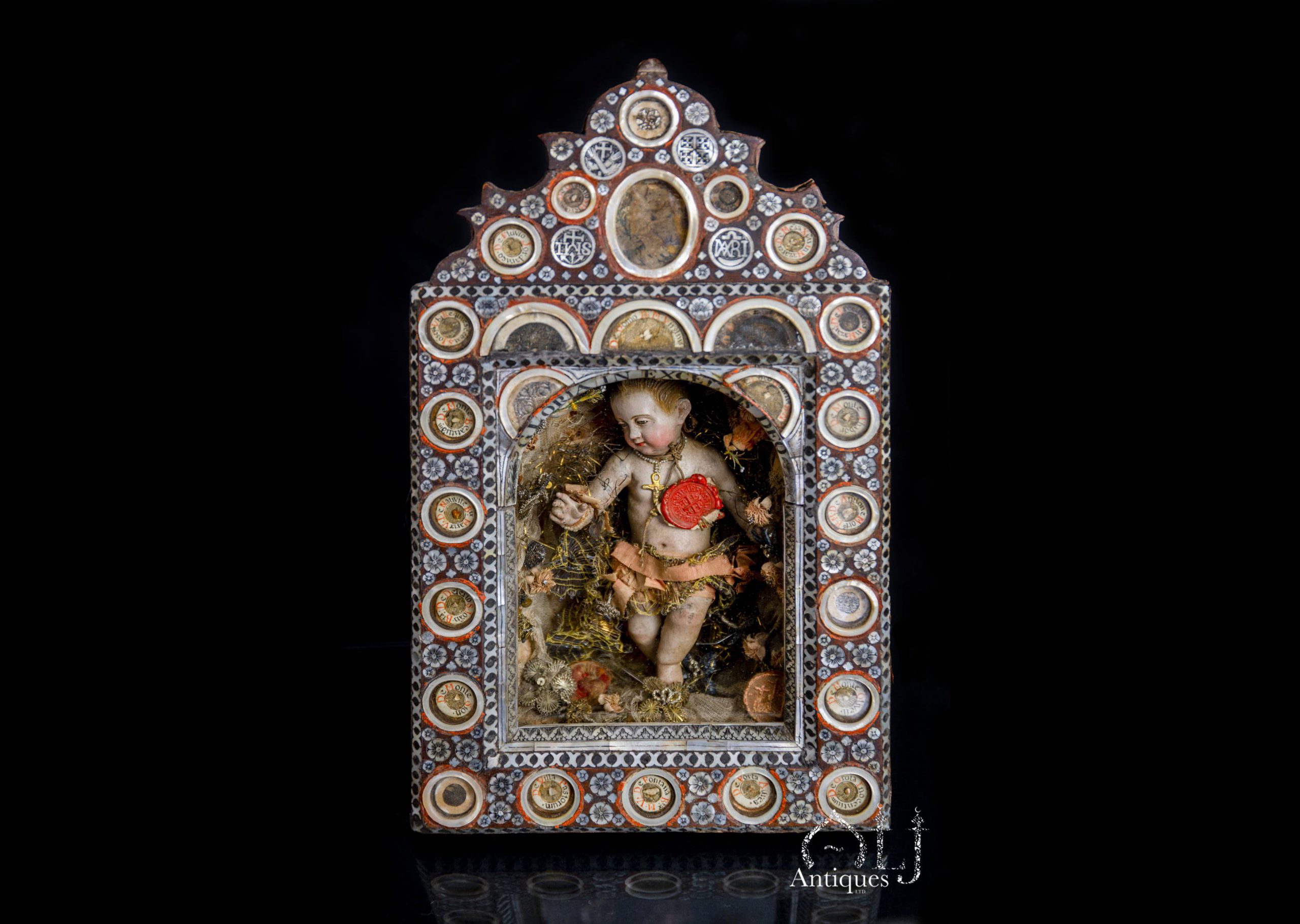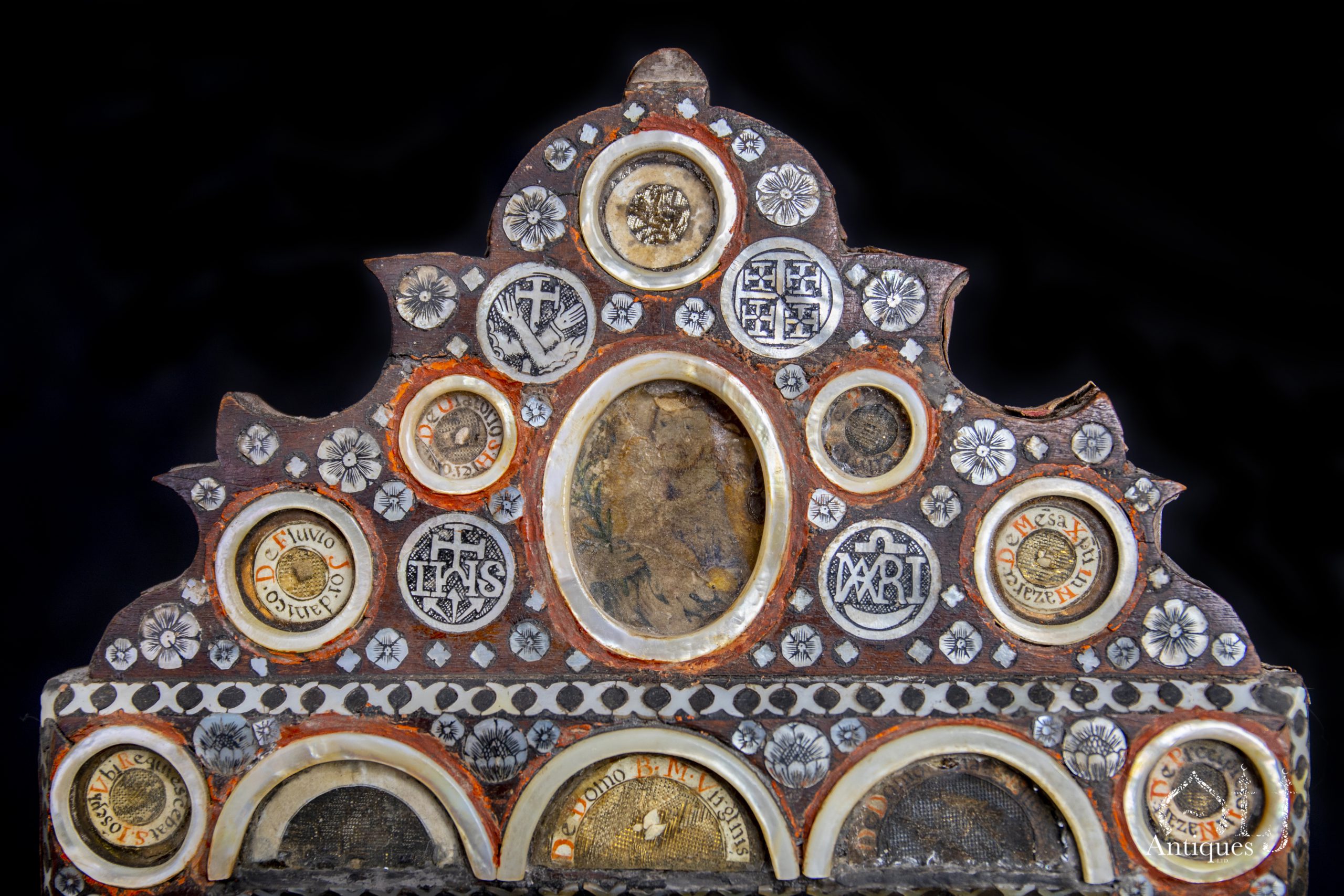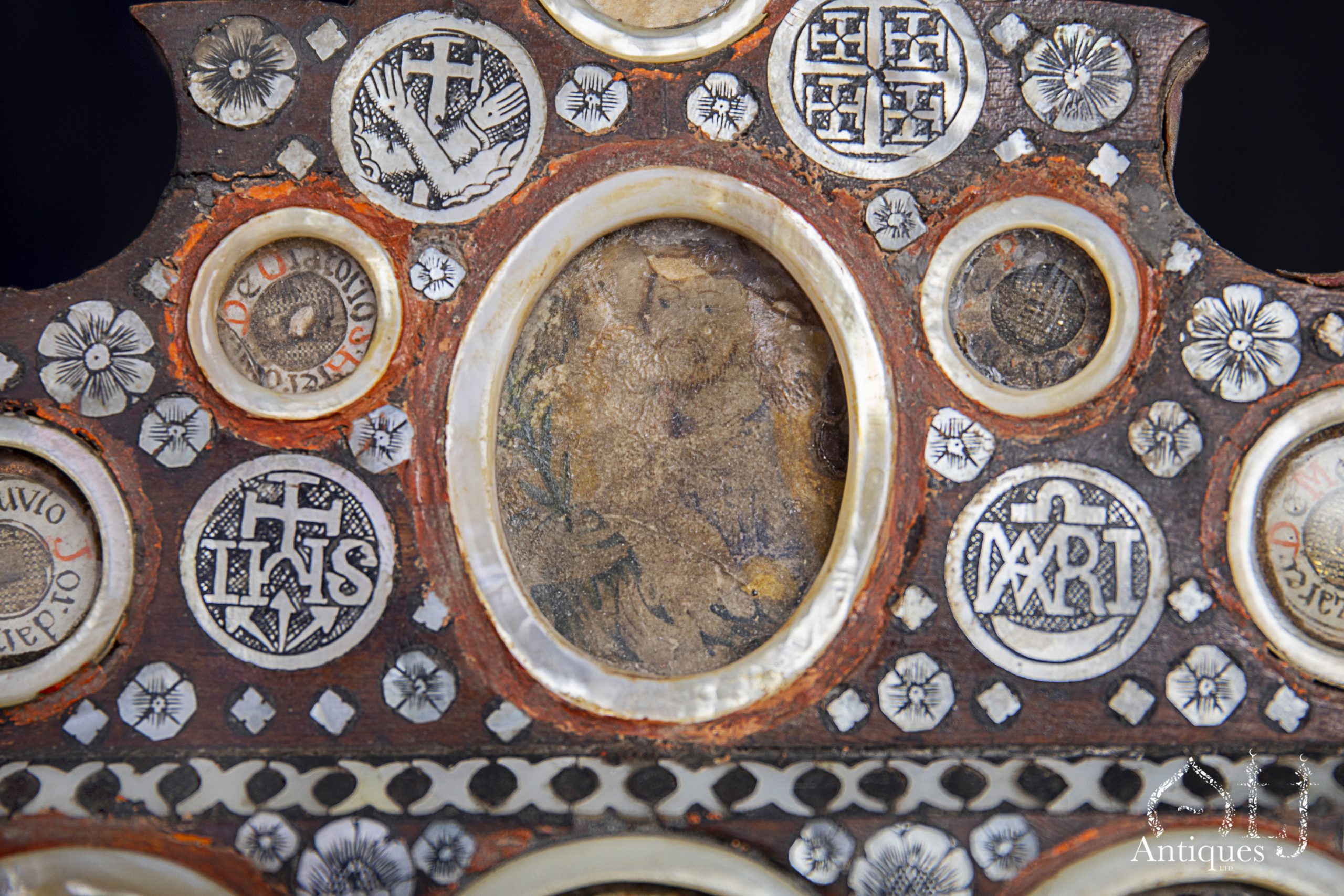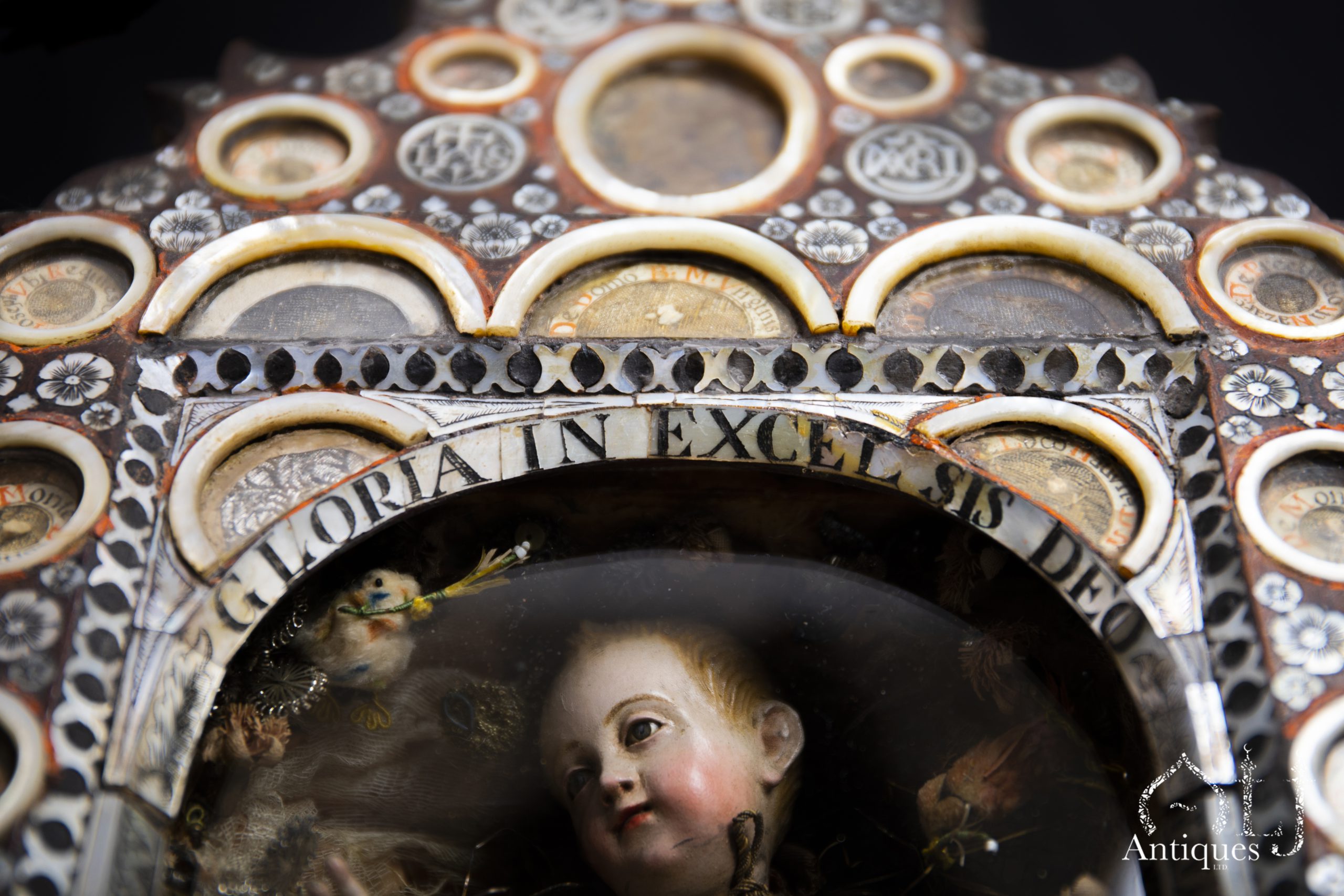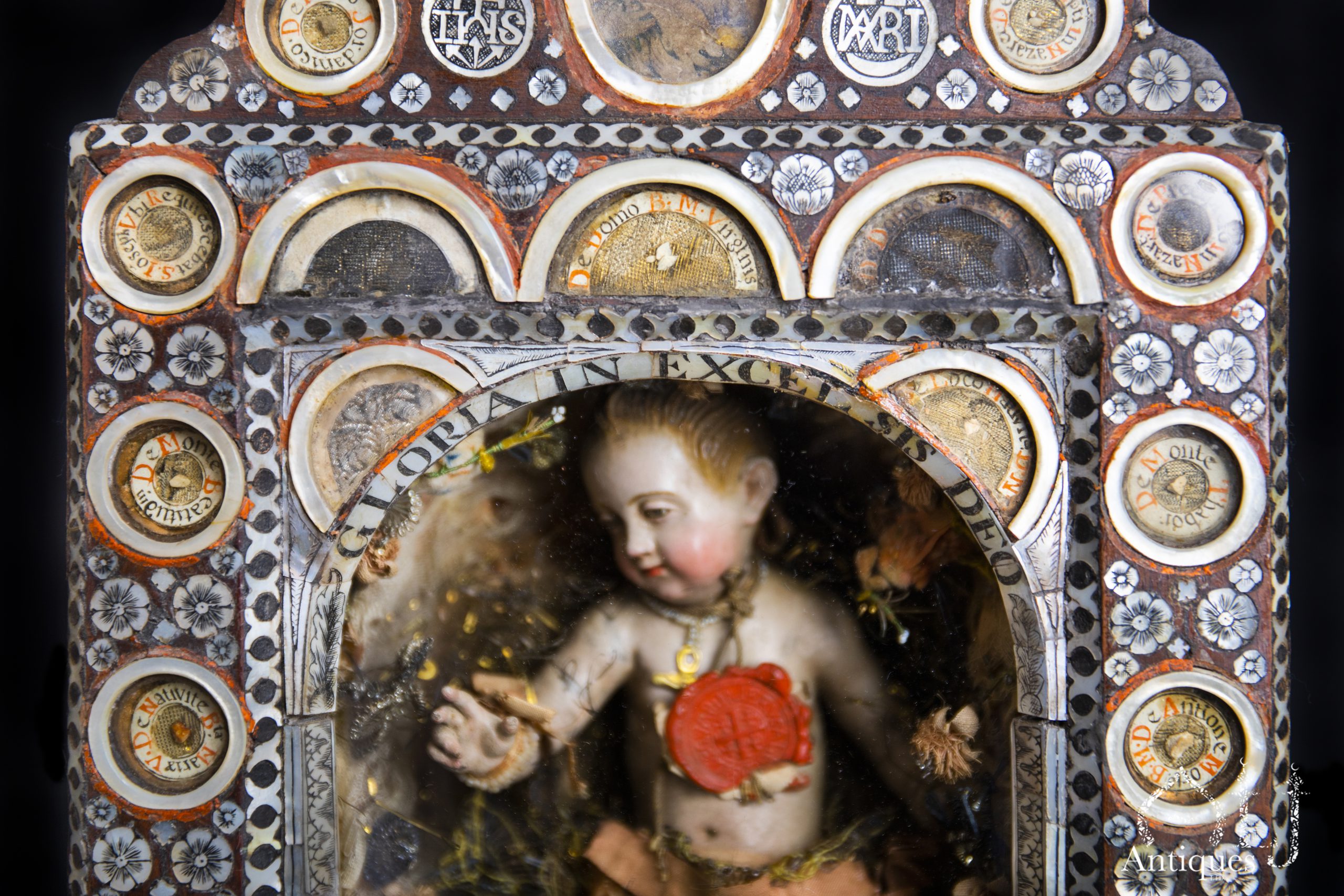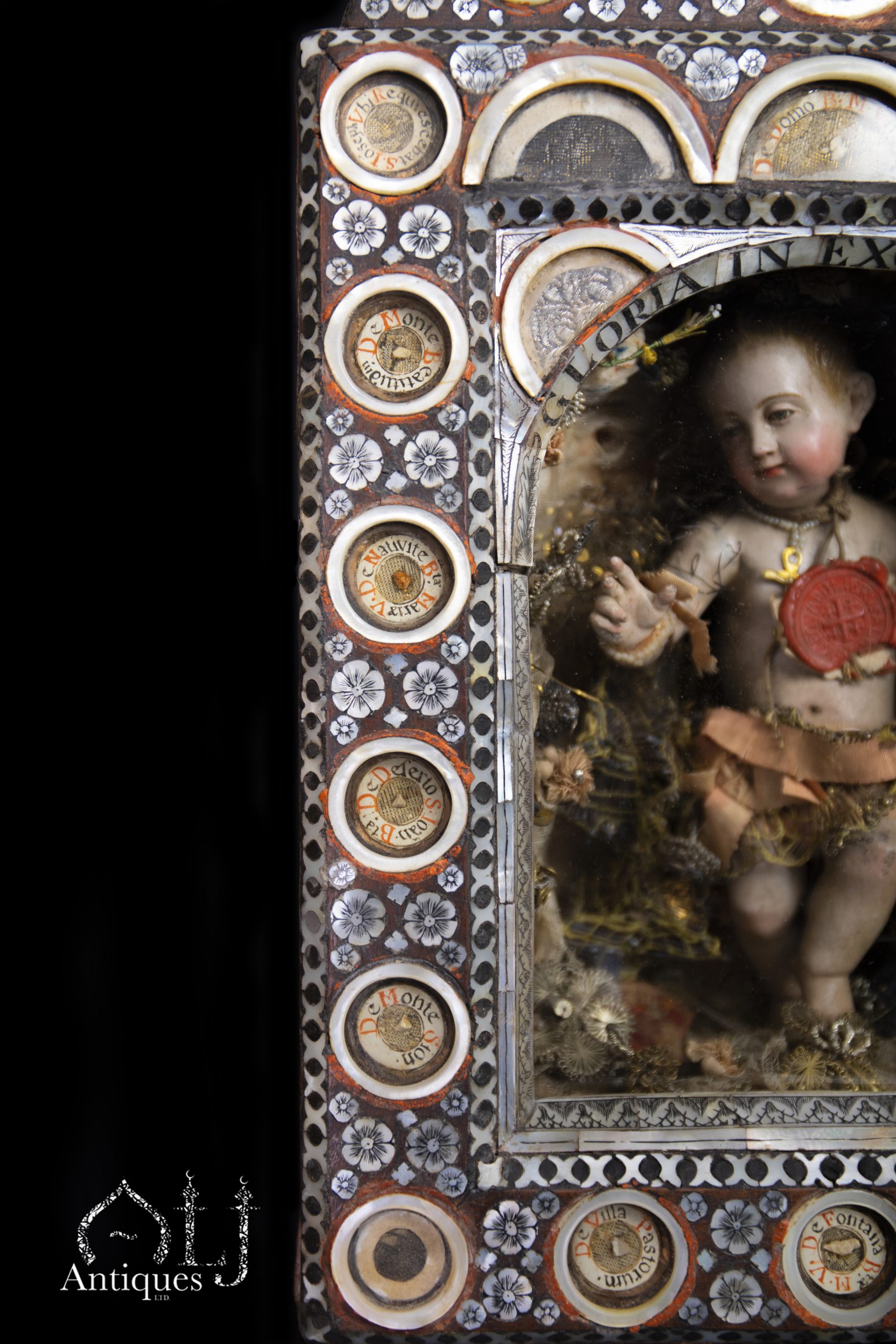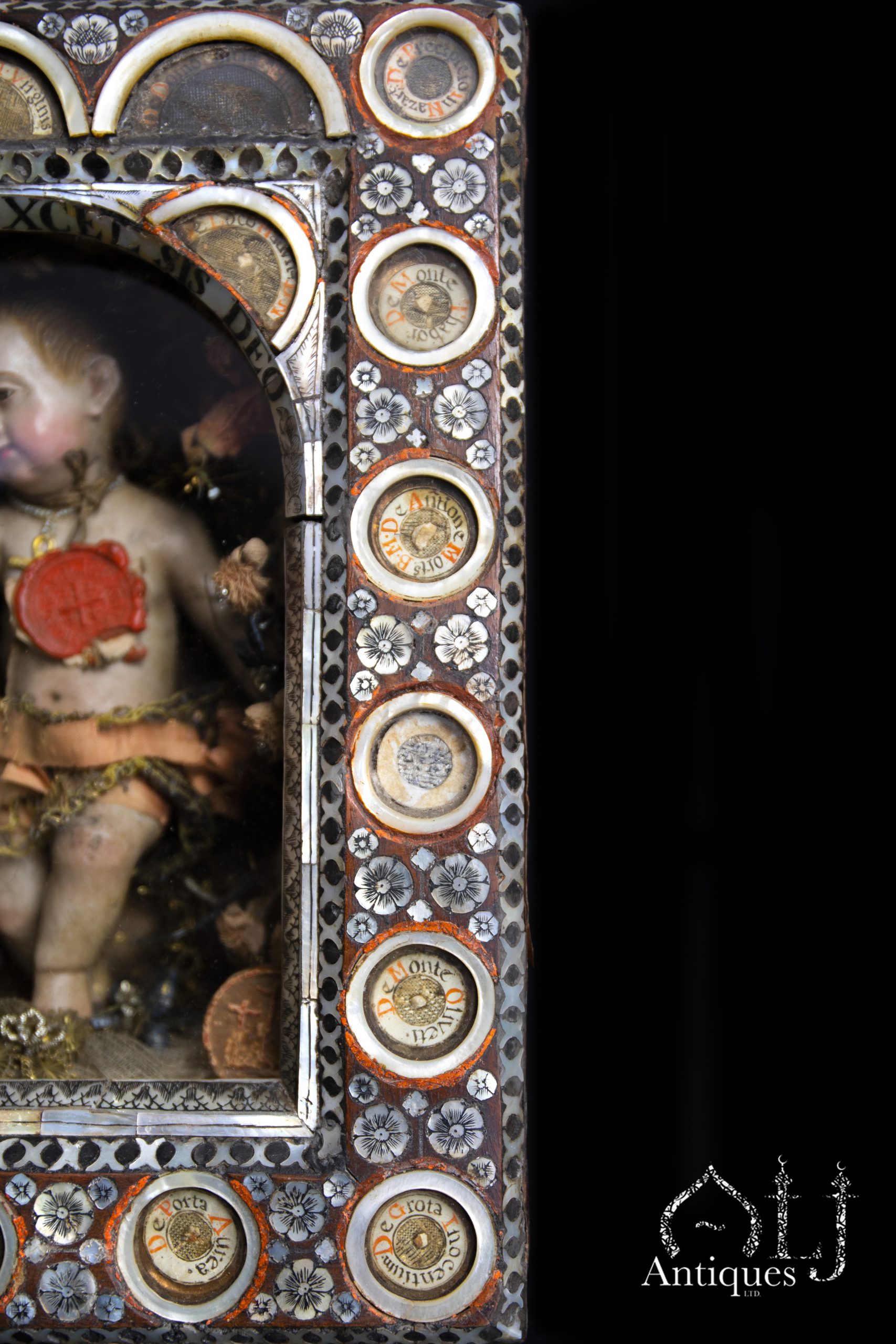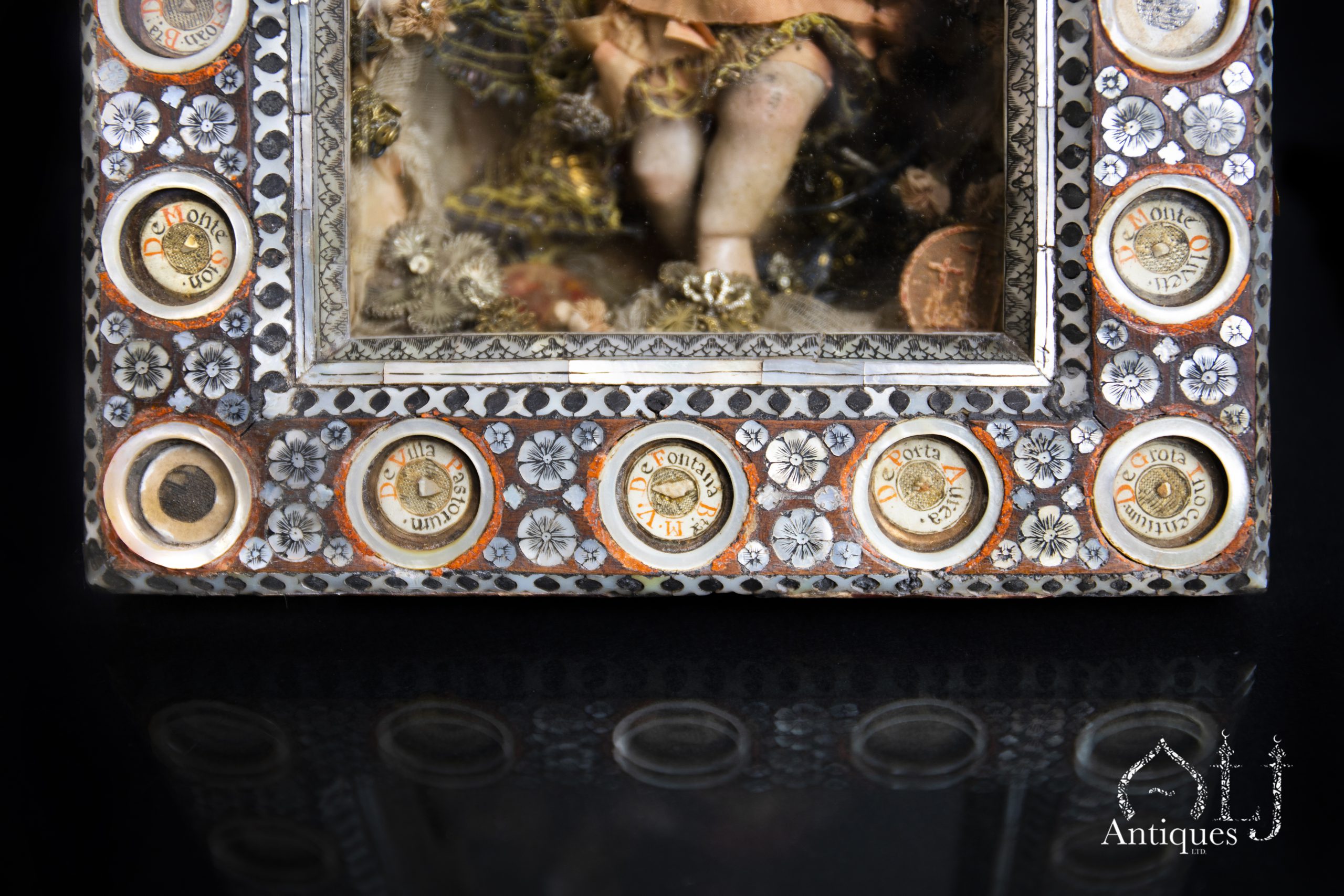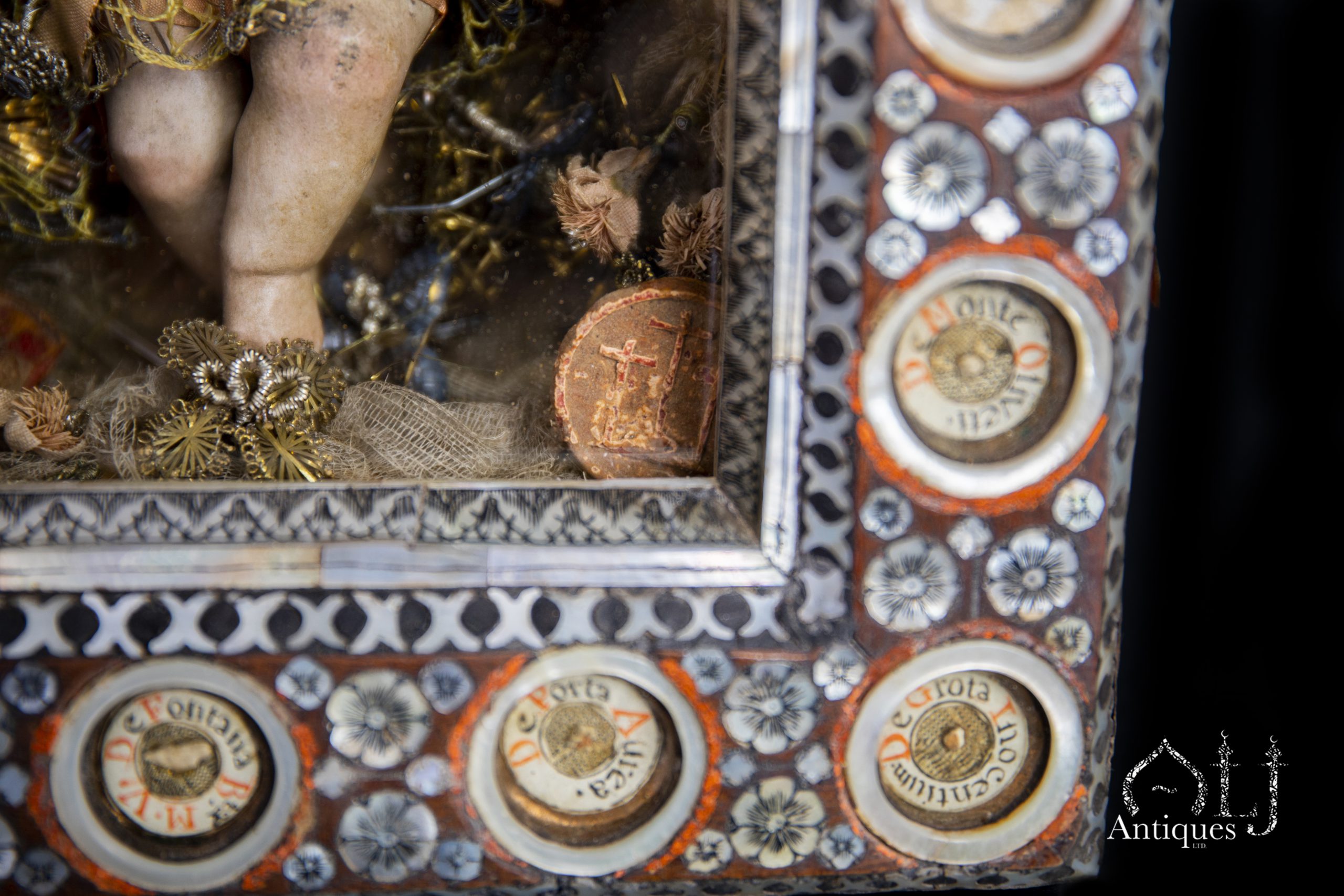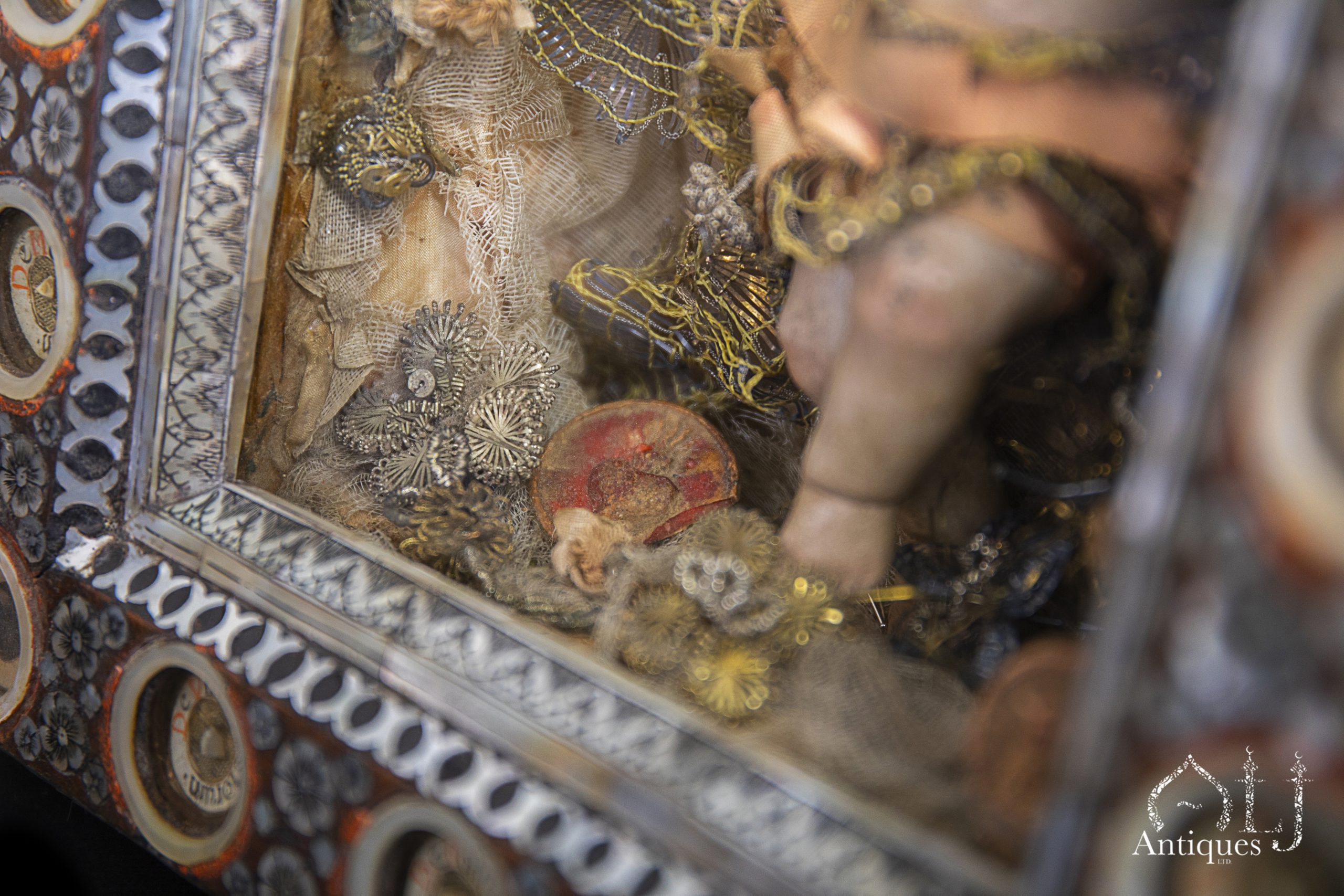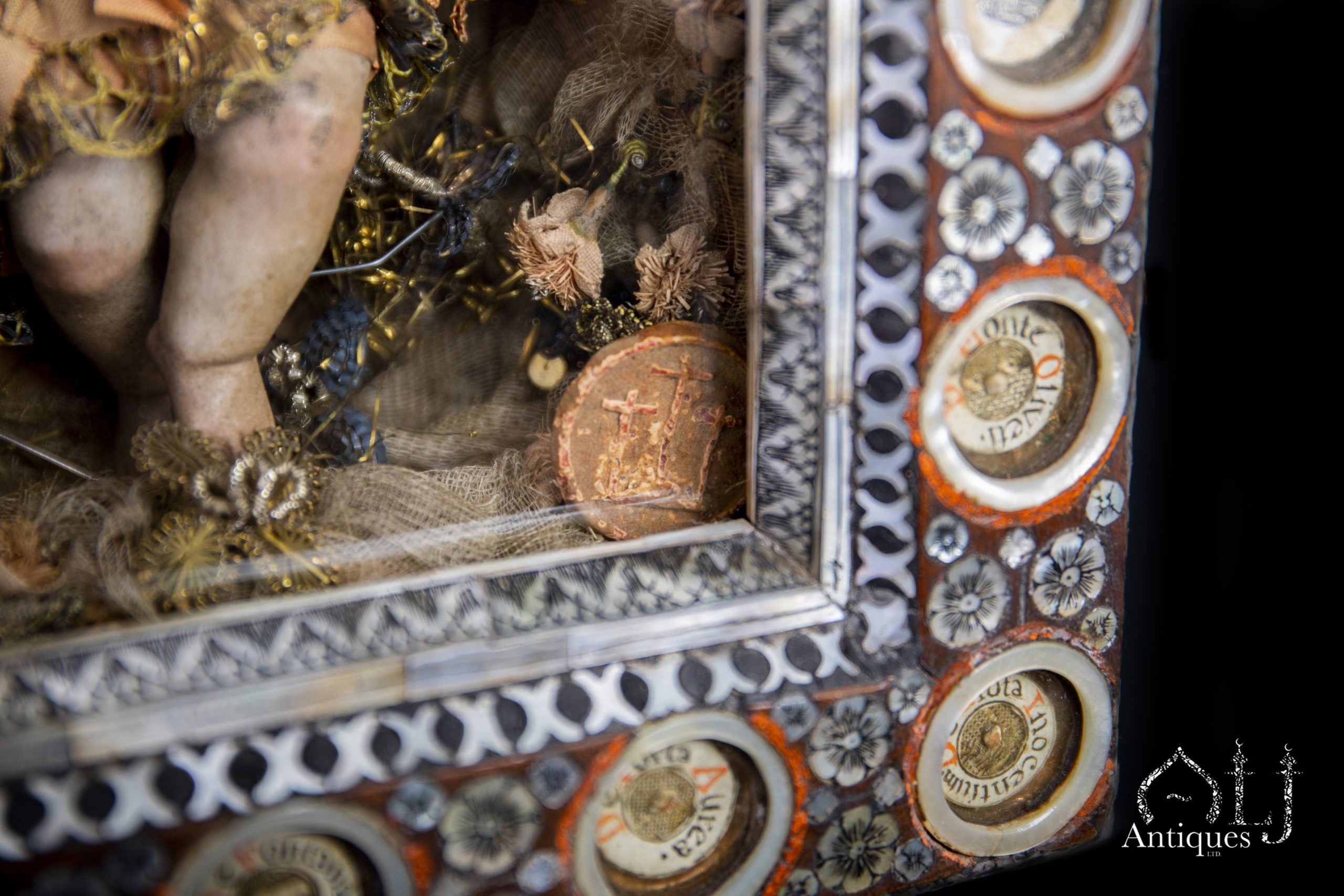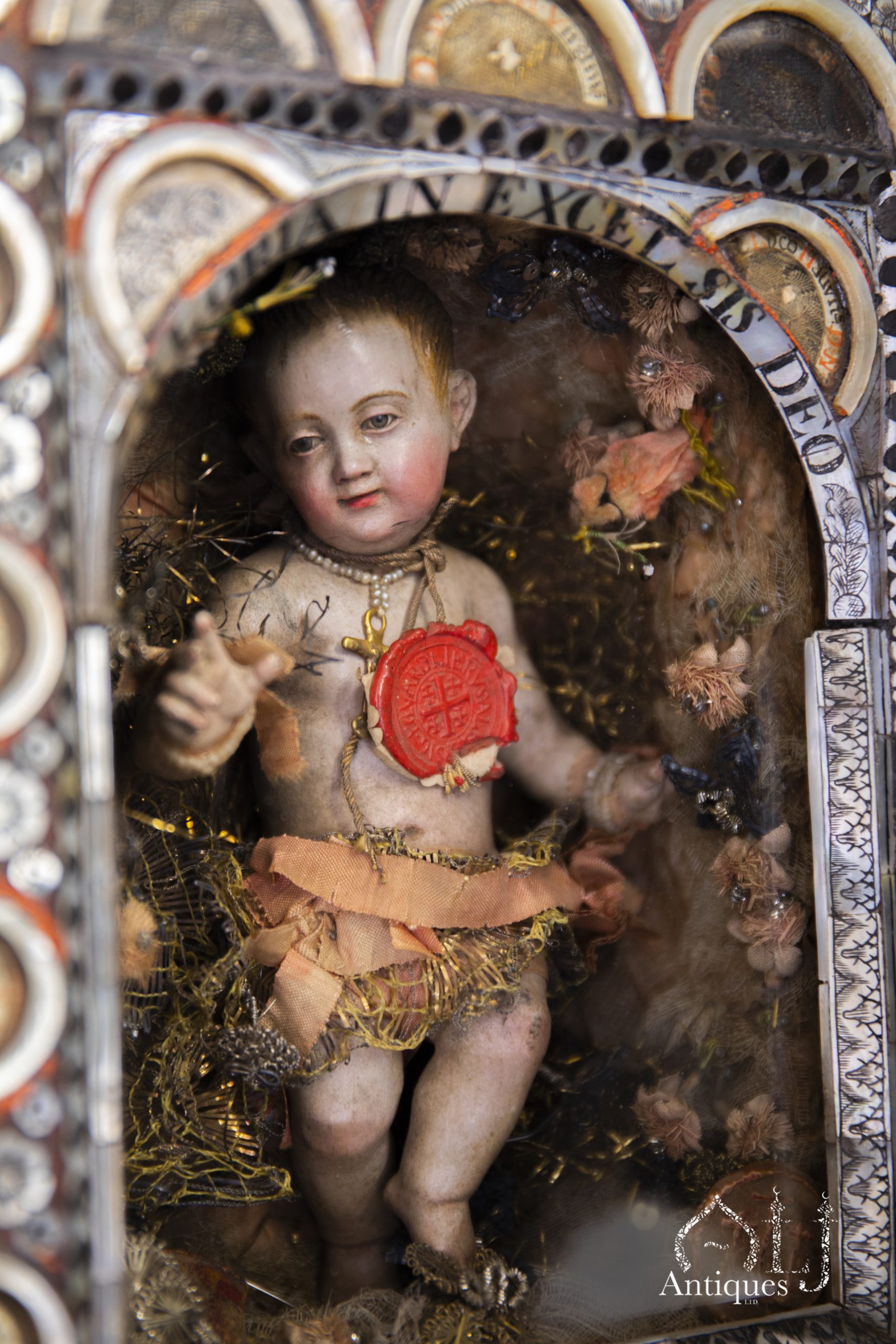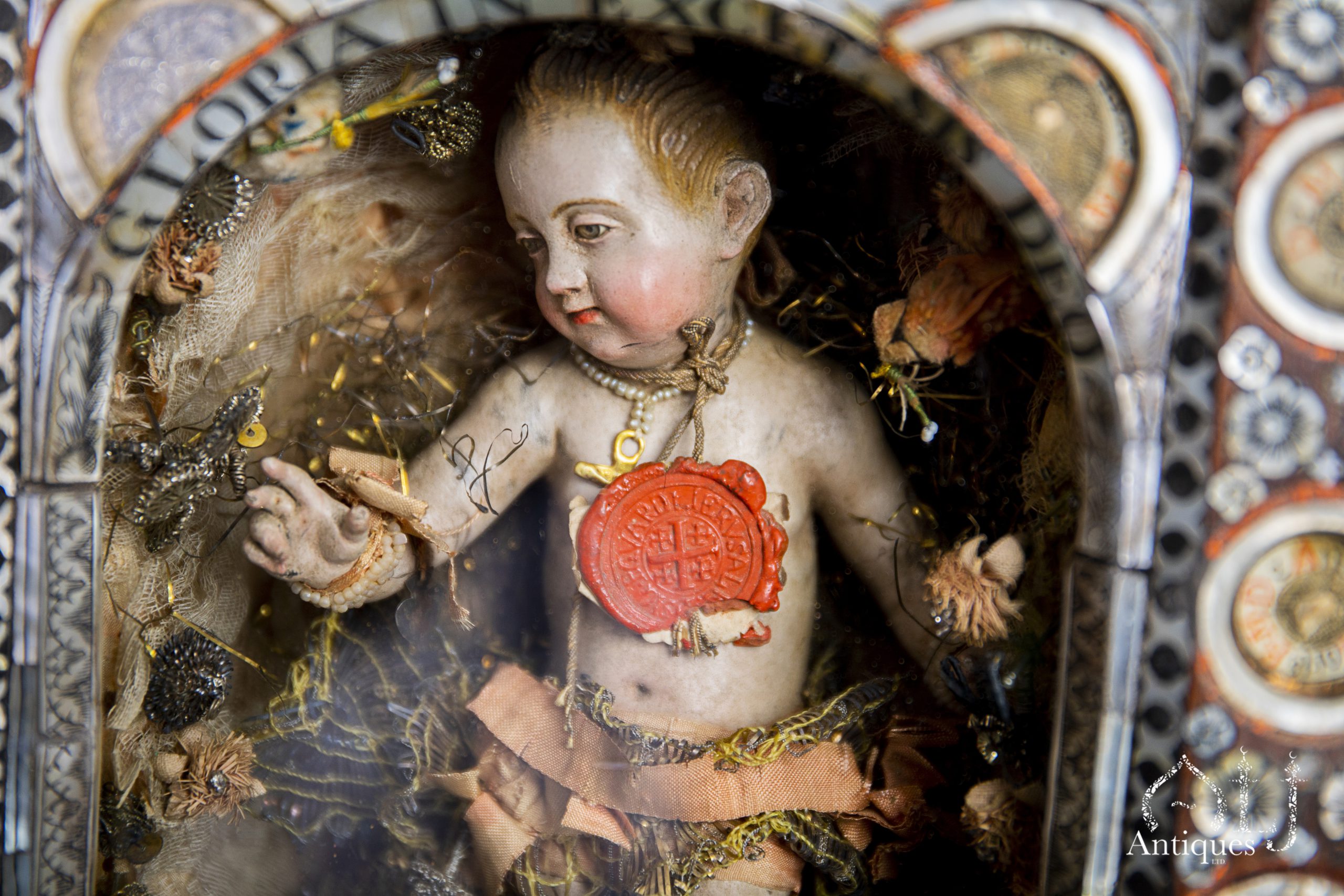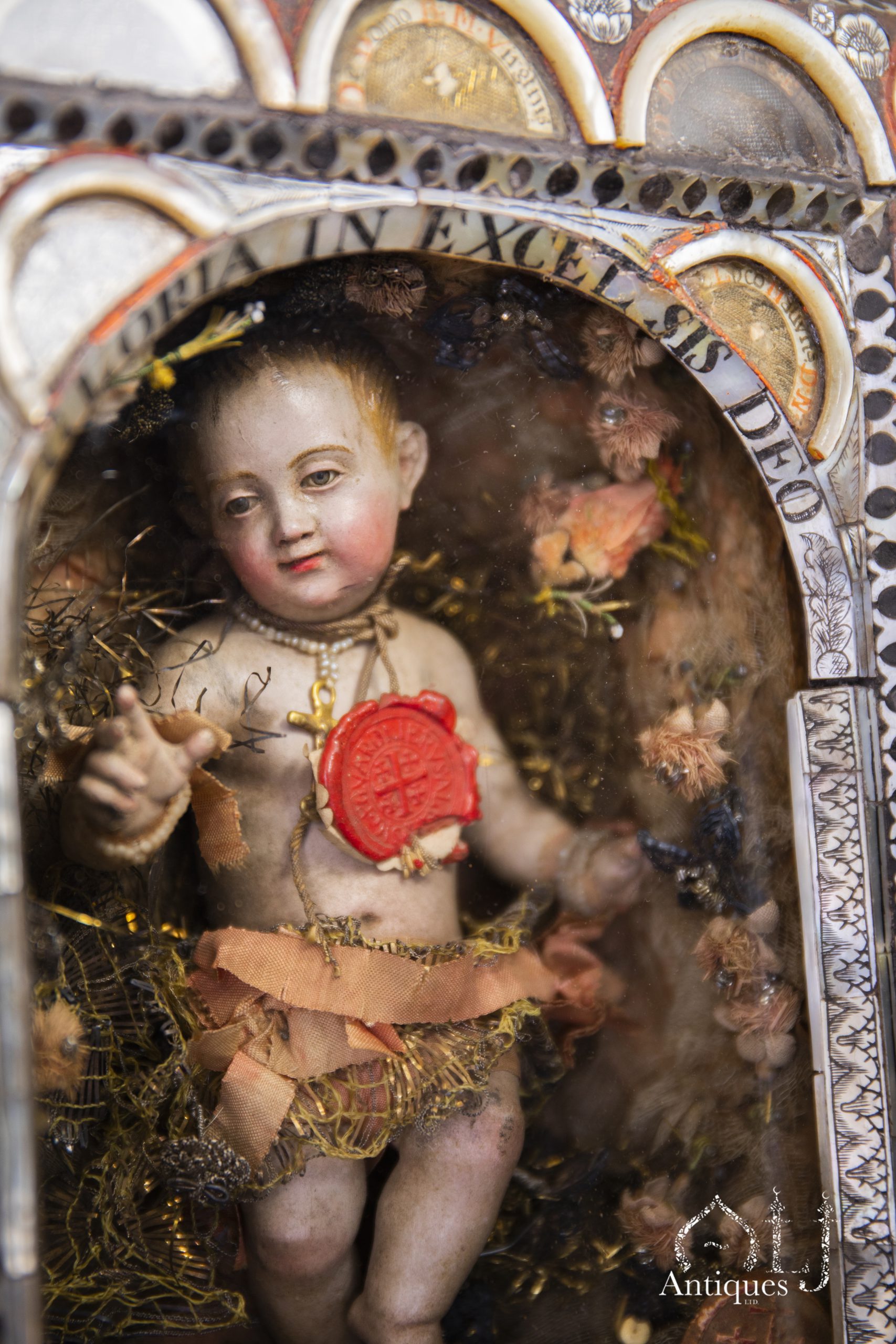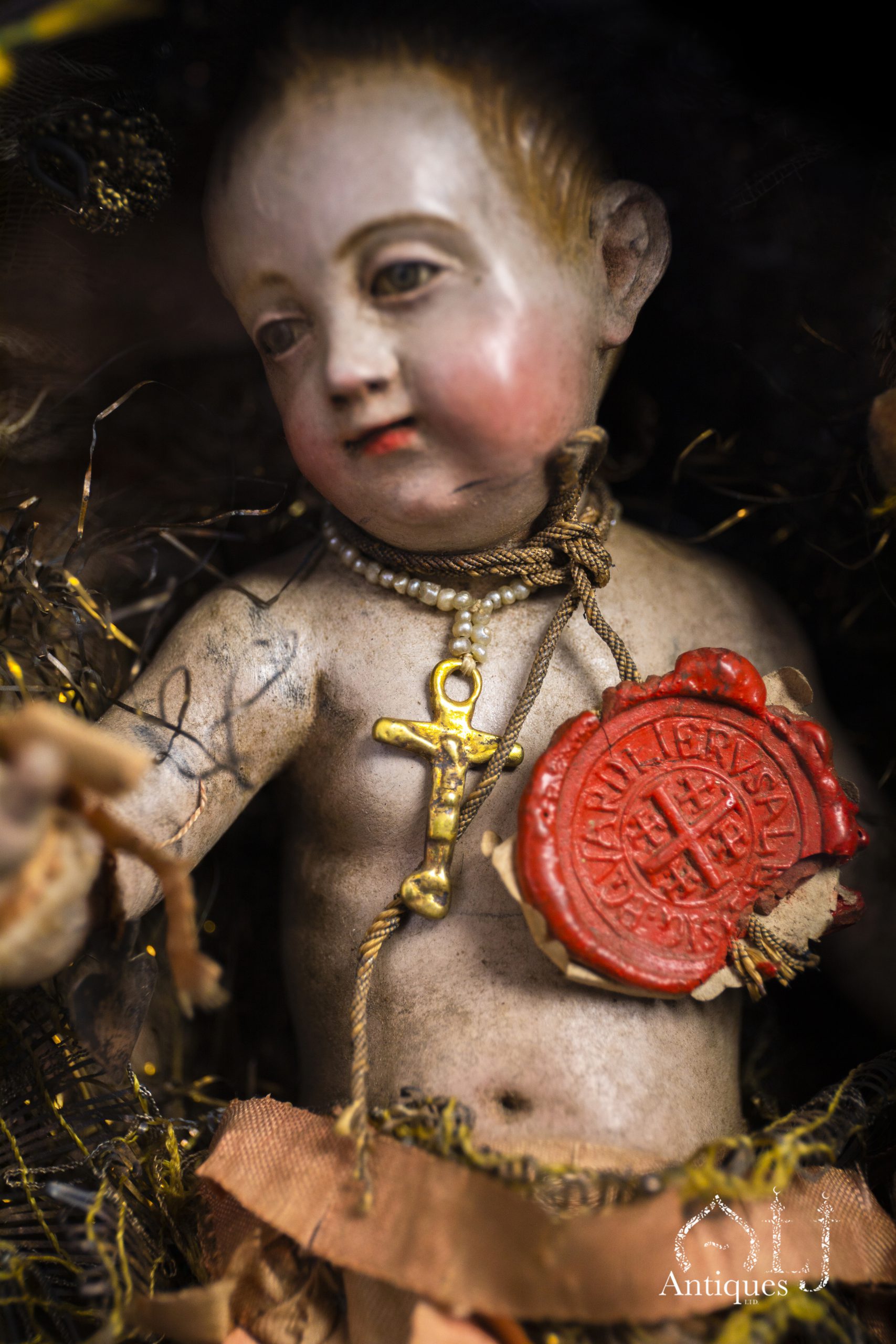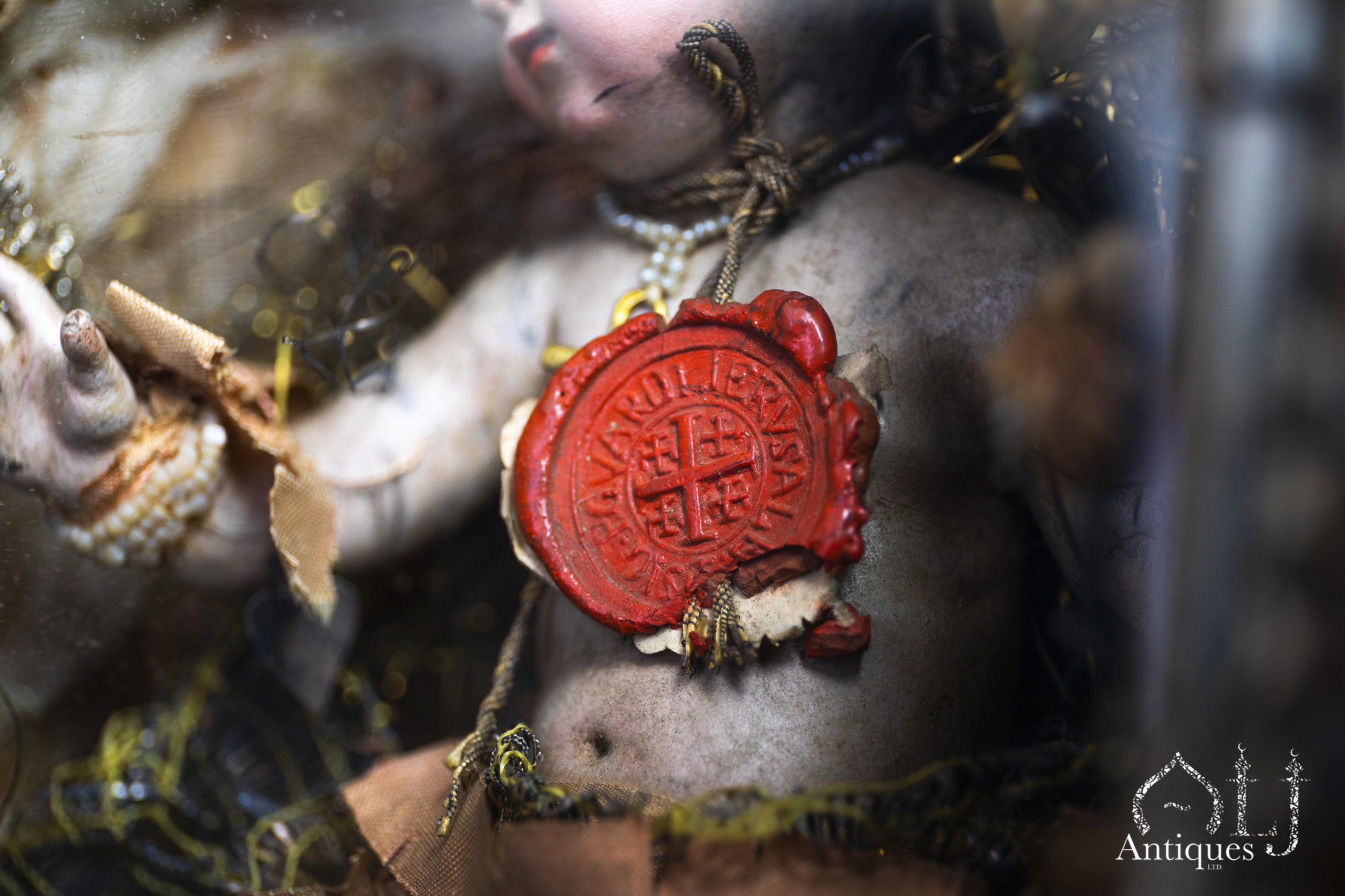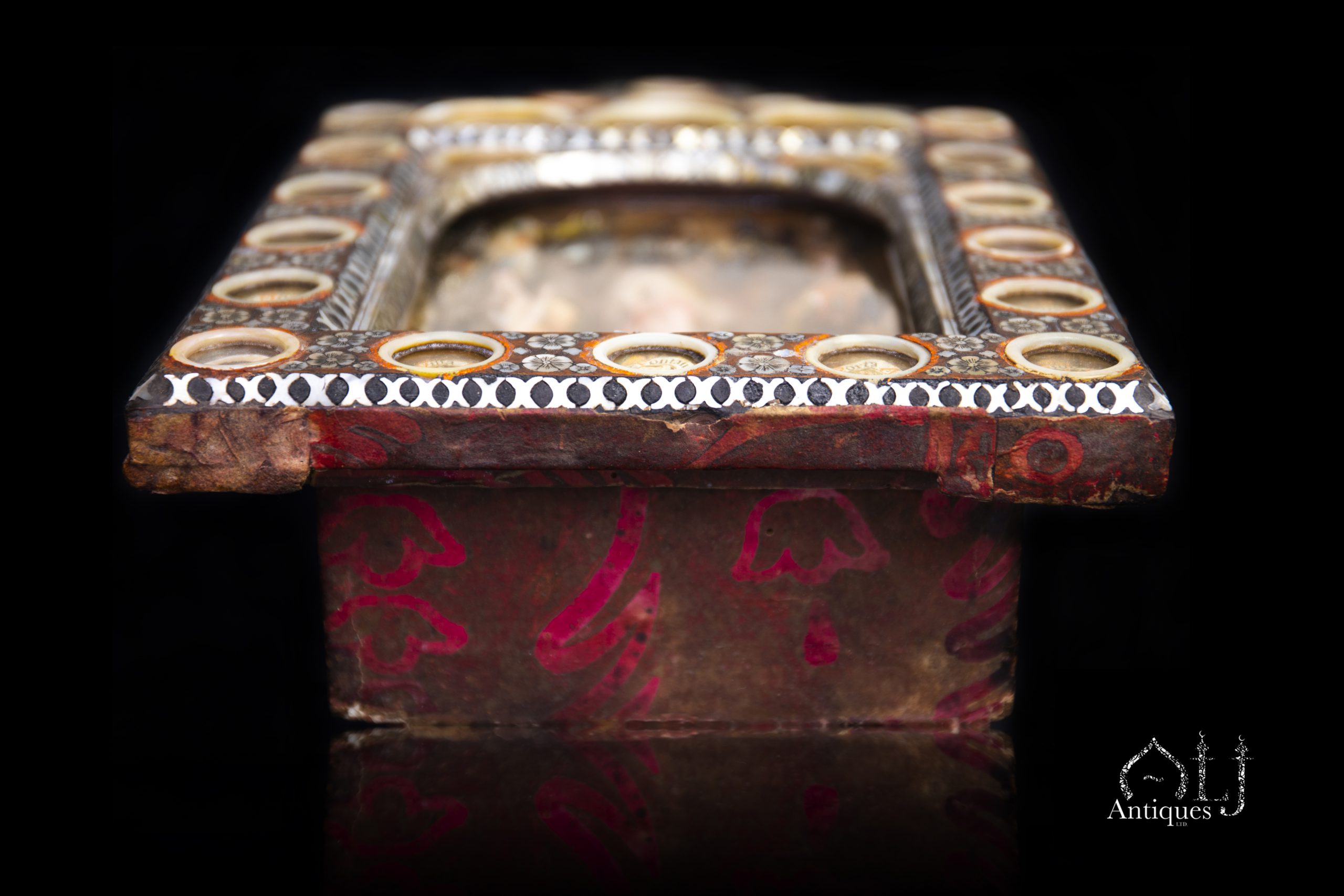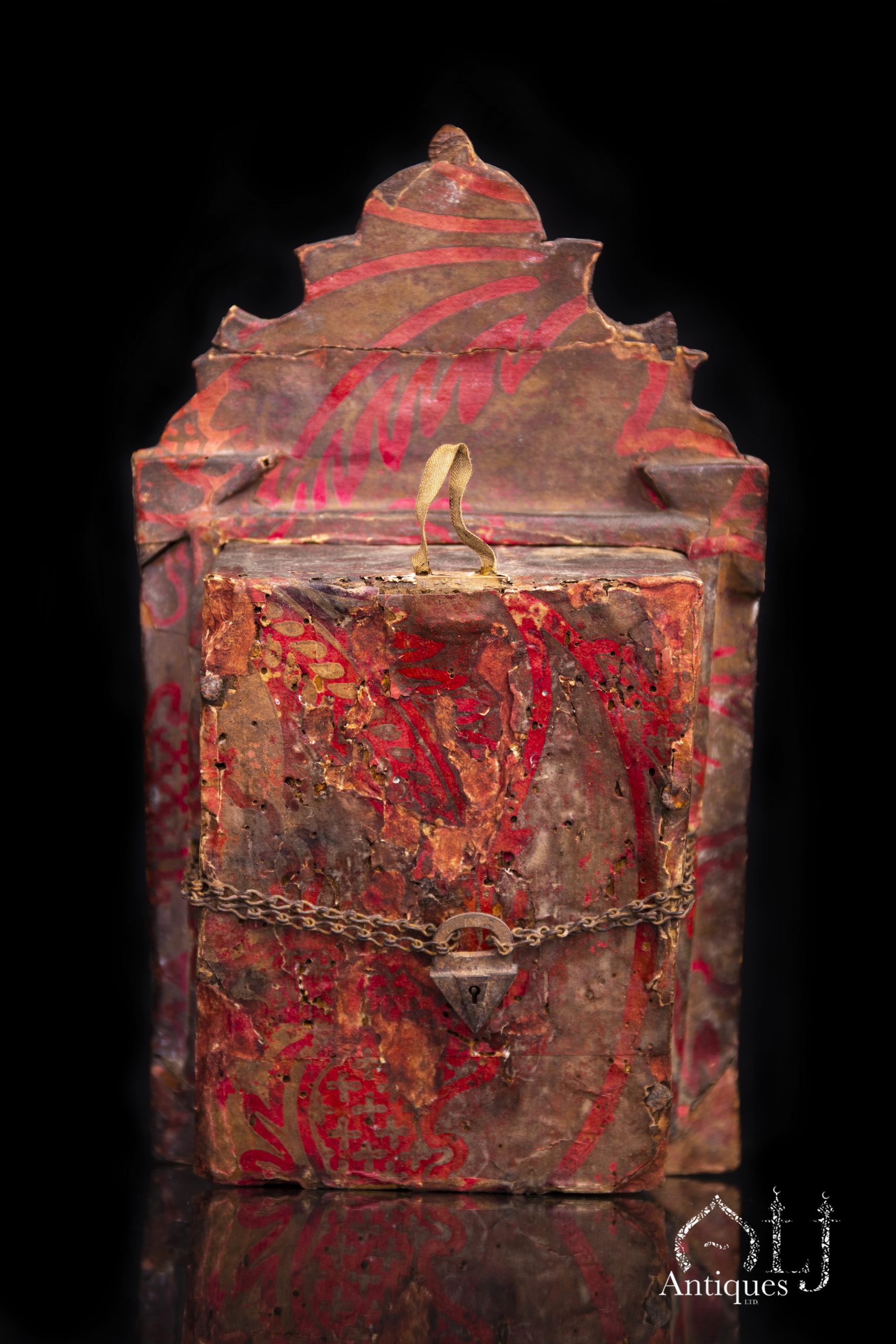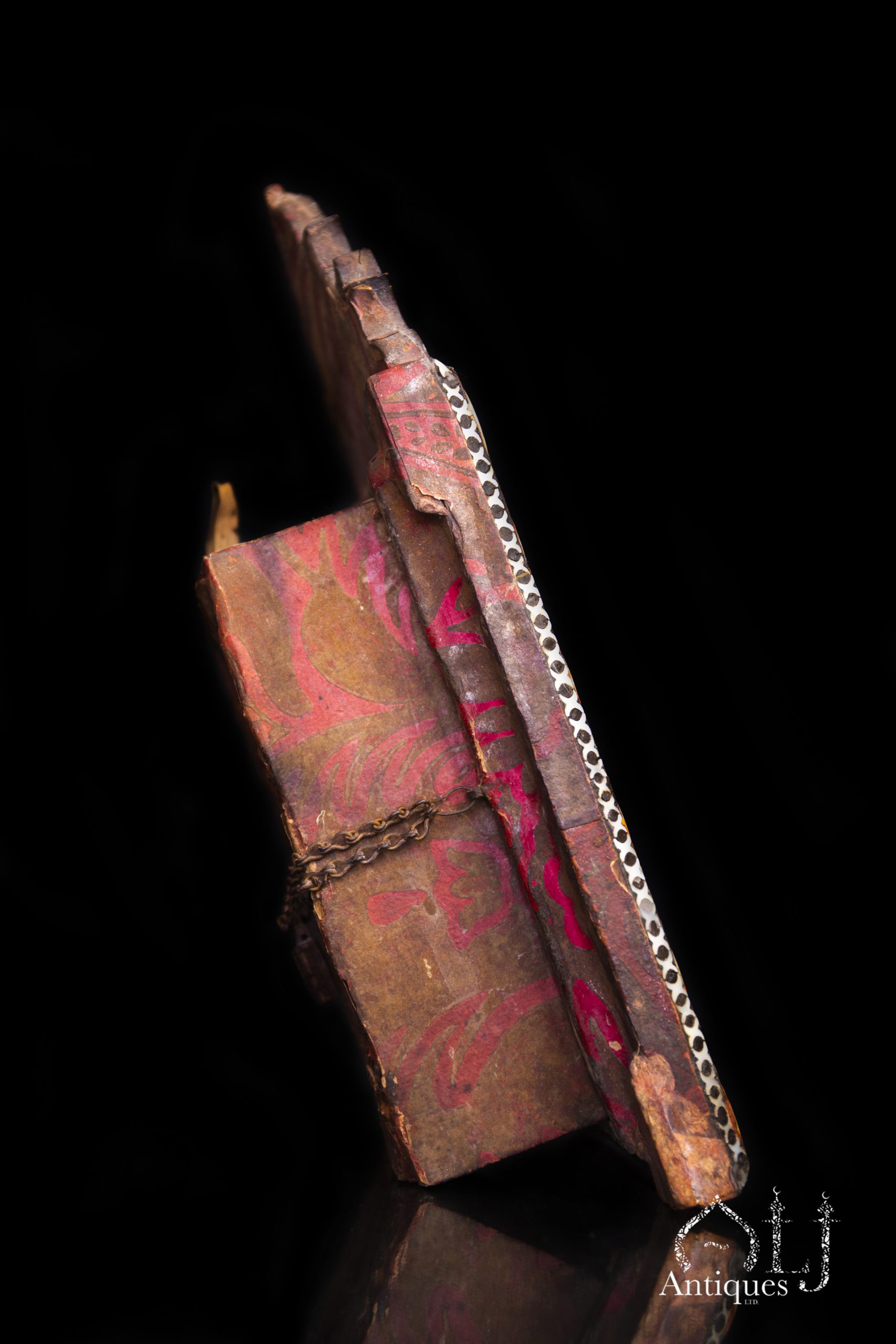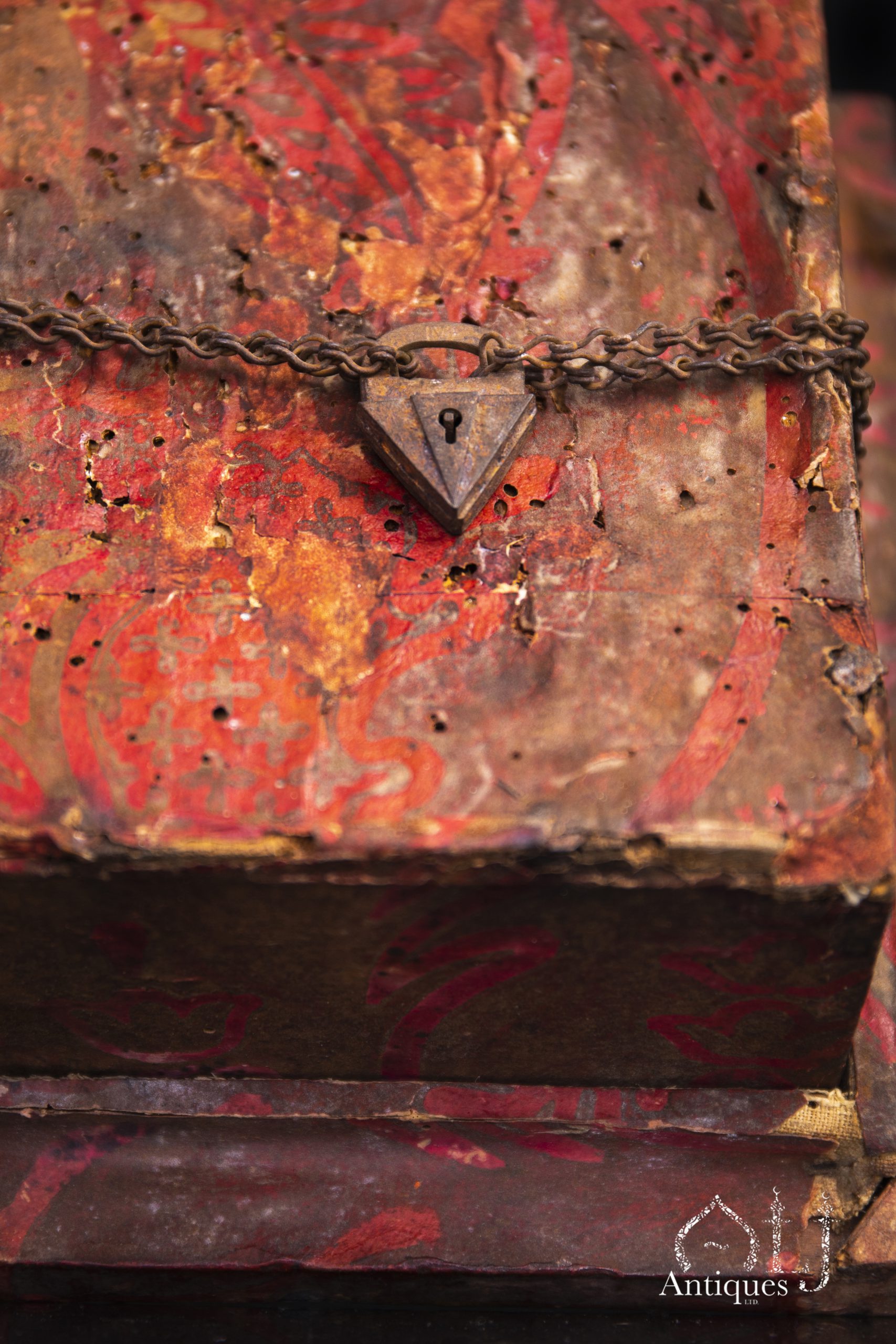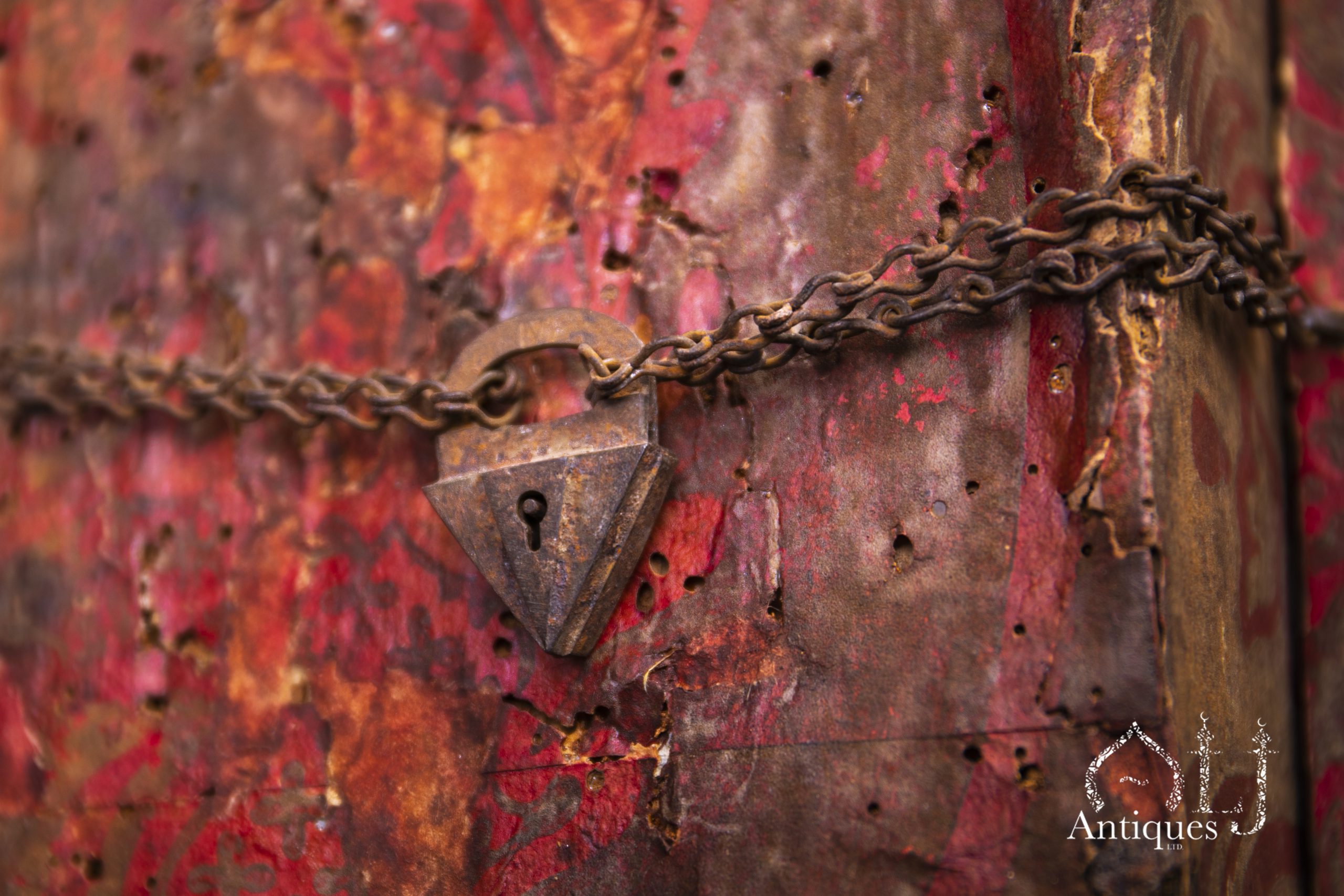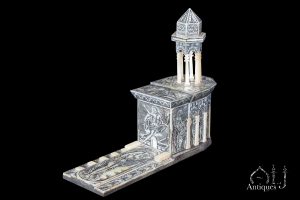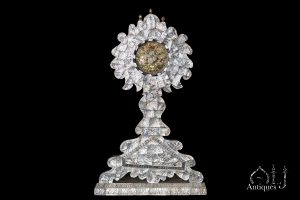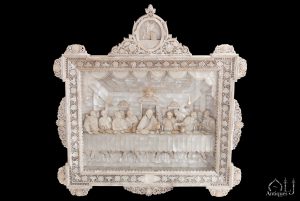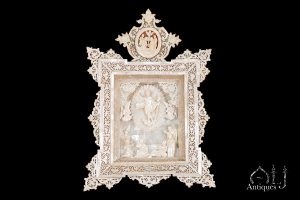Description
To the best of our knowledge this magnificent and very important Diorama and model which was made during the 18th. Century in Bethlehem – in Old Palestine is potentially only one of two recorded surviving examples.
And if this model is compared with all the other related existing high quality antique Dioramas which can be found at the world most important collections and museums and were also made in the Bethlehem area in the Holy lands out of wood overlaid with finely cut pieces of mother of pearl, the majority of these exquisite Dioramas were made at least a century later from our current rare lot.
In our humble opinion the existence and survival of this rare example will undoubtedly help in the re-writing of the history of the Dioramas production in the Holy lands.
The surface of the wooden frame of our present diorama (Sacrarium) is profusely adorned and beautifully inlaid with finely carved, engraved and tinged with black lac large and small arrays of flower buds pieces of mother of pearl and micro cross shaped pieces of mother of pearl beautifully interspersed with important 25 glazed relics (وعاء الذخائر المقدسة) framed with very fine rounded miniatures shaped mother of pearl frames.
The upper Crown shaped part of the wooden frame contains the following:-
The central part contain a painting probably painted on mica or leather depicting what has been considered the most gentlest Saint and the patron Saint of lost things (finder of lost items), the poor and the traveling people, Saint Antonio of Padua holding baby Jesus with a bunch of lily flowers as a symbol of the rebirth from death and of never ending spiritual love.
The reason why we believe that the male Saint image been depicted in our current lot is of Saint Antonio of Padua and not of Saint Joseph nor of Saint Christopher is the depiction and the use of four main Christian Catholic Church Religious Symbols representing the Franciscan Catholic Church founded in 1209 AD. By Saint Francis of Assisi.
For the Franciscan Catholic Church predominantly uses the image of Saint Antonio of Padua.
The following are the details of the four carved, engraved and tinged with black lac round pieces of mother of pearl, which are been represented in the following sequential order:-
1- The Franciscan Catholic Church symbol representing the pair of crossed Arms of the Franciscans.
The Franciscan order in Jerusalem is considered to be the guardian of the Holy Christian Places in the Holy Lands.
2- The medieval coat of arm of the Kingdom of Jerusalem (the Crusaders Cross is always related to Jerusalem including the flag of Jerusalem).
3- The I.H.S., Jesus Christ symbol, this symbol has many interpretations, such as the Greek abbreviated monogram of Jesus name, however according to the Franciscan, which is related to our present lot, this is the symbol of peace also in 1541 AD. St. Francis adopted the symbol with the three nails which had been used to crucify Jesus on the wooden Cross as shown in our lot, and surrounded by the sun and was considered as the seal of the Jesuit order, other interpretation is attributed to Constantine’s vision, the inscription is the abbreviation of (In Hoc Signo Vinces) translating to (In this Sign You Shall Conquer).
4-The monogram of the Blessed Virgin Mother Mary (Marian Symbols) with the crescent moon sign as a representation of the Mary’s miraculous conception.
The exterior and interior edges of the wooden frame is outlined, stacked and inlaid with rather very unusual row of finely cut small pieces of mother of pearl in the shape of the letter X surrounded and glued with black lac, this very bold design was probably been inspired from the façade of the 18th. Century palace or compound of (As’ad Pasha Al-Azem), the Ottoman governor in Damascus (قصر والي دمشق أسعد باشا العظم) .
The upper part of the arch is engraved and inscribed with bold Roman Latin letters with the following:-
Gloria in Excelsis Deo
Translating to Glory to God in the Highest.
In Christianity the reliquary or relics are the remains or residue of holy items taken from the passion of Christ including all the locations and the events leading up to the crucifixion of Jesus also those religious personalities who were associates during Jesus life including Saints and Martyrs.
These much prized objects were preserved and protected by churches and usually by well known individuals and the believes that those miniscule fragments have some kind of miraculous powers and have always been presented in an art form similar to our current lot.
Relics were considered as devotional ornaments and usually been represented as gesture of piety and were preserved in elaborate works of art produced by rather traditional form of containers occasionally made out of precious metal or other exquisite and expensive materials containing precious and semi precious stones and jewels, wrapped and maintained with expensive fabrics.
The Holy relic compartments in our current lot are set in an organised and harmonious manner in the carved wooden frame.
The relic compartments consist of circular, half-circular and oval shapes vessels or containers carved within the wooden frame with great precision and care.
These sacred relics consist of the remains or fragments taken from various Christian sacred religious sites in the holy Lands.
The relics are placed in the centre of each compartment probably glued on a hand-woven fabric matt made out of silver thread strings and surrounded by similar shaped paper, carefully hand inscribed in bold Roman Latin language in both black and red ink stating the source of these remains.
In order to preserve these sacred relics, they are tightly sealed and covered with thin mouth blown glass.
The glass is fixed to the main wooden frame with finely carved with high precision mother of pearl frames, the shapes of the mother of pearl frames commensurate with the shapes of the compartments.
Also to preserve these sacred remains from the external factors, the glass cover and the mother of pearl frames are fixed to the main body of the wooden frame with a red waxy material.
This very rare, important and exquisite reliquary nativity diorama consists of twenty-five relic compartments distributed and beautifully arranged throughout the thick solid wooden frame.
The contents of five relic compartments are empty or missing, the current empty compartments are of later replacements also some of the relic compartments are tarnished and hard to read.
The following are selected inscriptions (written in old Roman Latin Script) from the titles of the places where the sacred relics had been carefully selected from:-
-De Fluvio Jordanico
Translating to the Relic is from the River of Jordan.
-De Domino B. M. Virginis (the B. M. is probably for Beatae Mariae), translating to the Relic is from the resting place of the Blessed Virgin Mary.
– De Loco Nativits. D. N.
The Relic is probably from the Church of the Nativity.
-S. Ioseh Vbi Requiescebat
Probably the relic is related to the resting place of Saint Joseph. (The actual relic is missing).
-De Monte Sion.
Translating to the Relic is from the Mount of Sino.
-De Precipicio In Nazaret.
Probably translating to the Relic is from the Teaching Place in Nazareth. (The relic is missing or got loss and hiding behind the paper).
De Monte Thador
Translating to the Relic is from the Mount of Thabor (Tabor).
-De Monte Oliveti.
Translating to the Relic is from the Mount of Olives.
-De Grota Inocentium.
Translating to the Relic is from the Cave of the Innocents in Bethlehem.
-De Villa Pastorum.
Probably the Relic related to Saint Joseph and the Farmhouse or Village of the Shepherds.
De Monte Beatitudinis.
Translating to the Relic is from the Mount of Beatitudes.
-M. V. De Fontana Bta
Translating to the Relic is from the Blessed Fountain or Spring of Virgin Mary, (Mary’s Well).
– De Porta Ourea.
Translating to the Relic is from the Golden Gate where is believed that Jesus had last entered Jerusalem through.
The exceptionally fine design and the symmetrical dimensions of the current Diorama gives a clear indication that the already carved statue of Baby Jesus was brought before designing the Diorama.
Especially the crèche or the room where Baby Jesus lies is very obvious that it was exactly made to fit the required size of the statue.
This is a clear evident that the main two parts, the figure of Baby Jesus and the structure of the diorama are both the originals and belongs to each other, (No substitutions).
During the 18th century finely carved with very high quality wooden figures were made at various parts of the world mainly in the European countries, some colonised countries and South America etc. Various materials were used such as Clay, Wood, Rags, Bone, Paper Mache, ivory and wax in an attempt to make those figures as life as possible.
The Exquisite details of the Baroque style of the beautifully carved polychrome painted and gilded wooden statue of infant Jesus the body is left bare but to preserve the Baby’s modesty, his privacy is covered with ribbons of thin pink silk fabric mixed with net like of thin strings of metal probably made out of gold and silver knotted together with fine silk fabric, a butterfly shaped ties is mounted on both hands.
Also Baby Jesus is lying and resting on straw like material probably made out of thin strings of metal probably made out of gold and silver knotted together with fine silk fabric.
To be able to create this gorgeous looking Baby various colours similar to the original colours of a real baby were used in to represent the baby as the Holy Nativity Statue of Jesus.
The figure is deeply sculptured like the ears with blond dyed hair, lovely smiling face with red-rose colour of the blushed cheeks and body parts.
The charming lively looking baby’s eyes are made of enamelled glass-paste.
The baby’s right hand is raised in benediction and blessings towards those who observe him.
The child (Nino Jesus) or nativity figurine has lovely smiling face, with glass eyes and beautifully polychromed potentially the figure is made out of wood, the origin of the figure is anonymous (Probably of European origin (Italian or Spanish).
Very similar statue of the Divine Infant Jesus but probably made of a much later date and of European origin is been occasionally exhibited to the worshippers at the sanctuary in Bethlehem.
In this lot Baby Jesus is enriched with accessories and surrounded with various types of embroideries.
A necklace apparently made of ancient gold in the form of a cross is placed around baby Jesus neck, the necklace also contain beautiful strings of seed pearls, similar strings of seed pearls are also used as bracelets on both baby’s hands.
Also Baby Jesus’s bed is surrounded by flying birds holding branches of flowers in their peaks to entertain the baby, various types of flowers potentially made out of silver strings scattered all over the place.
Other similar but later examples of Sacred Figures which were commissioned by the most powerful Churches and Prominent Individuals in Europe to be gifted to the main Christian Sites in the Holy lands, such as the Church of the Nativity and the Milk Grotto Church in Bethlehem and the Holy Sepulchre in Jerusalem, these very high quality figures representing Baby Jesus, Mary and the child and Jesus Christ were made in the most sophisticated ways at the time by the most talented and well known artists, carvers and workshops in Europe mainly in Italy, Spain, Germany, France and other European Countries.
An Image representing a magnificent late 19th c. large mother of pearl overlaid Diorama made in Bethlehem hosing a late 18th c.- early 19th c. European Polychromed wooden figure of Mary and Baby Jesus located at the Milk Grotto in Bethlehem.
Two probably 19th c. European carved and polychromed wooden figures depicting Baby Jesus in the Crèche which has been celebrated with special ceremonies in the Church of the Nativity every year during the period of Christmas and at the Milk Grotto in Bethlehem.
Three Important and meaningful Red Wax Seals can be found in the Sealed Room of which Infant Jesus Lies
1- an important Wax Seal bears the Coat of Arms of Jerusalem surrounded by a Latin Script, The Wax seal is knotted and hanging by a thick string from Baby Jesus neck.
The wax seal is slightly damaged (chipped), but we believe the available Latin Script reads as follows:-
SIG. P.G. VARDI. IERVSALEM, (SIG. is probably the abbreviated word of the signature and the second letter G. is probably the abbreviation of the Latin word Guardi, translating to the Guards).
A Signature on the Wax Seal of the Father and Keeper P. G. Vardi from Jerusalem)!
2- a second important and meaningful Wax Seal found laying on the silky grounds of Baby Jesus Room and bears the Catholic Church logo of the three Crosses of the Calvary Hill, where Jesus Christ was crucified.
An image of the Three Crosses of the Calvary Hill (Golgotha)
3- another important Wax Seal found lying on the silky grounds of Baby Jesus Room and bears the Catholic Church logo of the Immaculate Heart of the Virgin Mary brings out the burning flames from the top, also with a bit of damage (chipped & worn).
An image of the Immaculate Heart Symbol of Mary with the Burning Flame
All the above three important Wax Seals potentially symbolises the sacred locations of which this important Diorama might have had the blessings, by physically being in all of these important Holy sites.
The room where baby Jesus lay resting is sealed through the backside of the Diorama by a thick hand twisted iron chain locked with a padlock, the letter M is marked on the padlock, unfortunately the key is missing.
The backside of the diorama is covered with hand painted paper in different shades of red and brown (the brown was probably of a yellowish colour but had been tarnished with time) with marbled effect decoration, the diorama is sealed with a hand twisted chain and locked with an original padlock.

